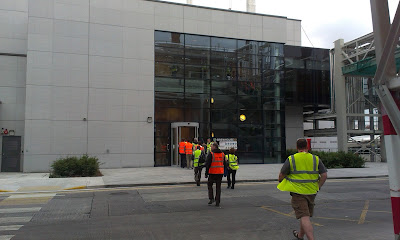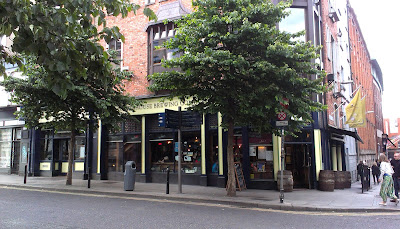 |
| M&S House-magazine |
I would say that this particular Irish stout is it a different league to many of the others I have tried over the years which brings me on to Guinness, one of the best-known beer brands in the world and the runaway market leader when it comes to producing dry Irish stout. Guinness is regarded as the yardstick by which other stouts are measured, but despite the worldwide fame of the beer I've never been a huge fan, and certainly not of the draught version. I find it rather thin, and the roasted barley used in its production imparts a harsh taste, which I am not over keen on.
Leaving Draught Guinness to one side, back in the early days of CAMRA, I went through a phase of drinking bottled Guinness. At the time Guinness Extra Stout in bottled form, was naturally conditioned, having a thin layer of sedimentary yeast at the bottom of the bottle. CAMRA described the beer as “Real Ale in a bottle,” due to the fact that the yeast allowed the beer to condition and mature, naturally in the bottle. I was a lot more serious in those days about following CAMRA guidelines, and whilst bottled Guinness was an acceptable, and satisfying beer, it only came in half pint, 275 millilitre bottles. This was a real disadvantage, volume wise, compared to those drinking draught beer, even if it was keg, as when drinking in rounds, I always finished my beer, way before my companions. I was the one left with an empty glass, waiting for others to finish, and get a new round in. As well as still containing live yeast, another strange hangover from the past was that Guinness allowed small regional breweries to bottle their Extra Stout on their behalf. The beer was delivered in bulk, by tanker, for the breweries to package, and then sell throughout their various tied estates. I'm not quite sure when this practise died out, or when Guinness Extra Stout ceased to be bottle conditioned, but it may have occurred when the company closed their large brewery at Park Royal, to the West of London, and concentrated all production at their main St James’s Gate Brewery in Dublin. |
| Heineken ad - do they now own both brands? |
Towards the end of the 1970s two other brands of Irish stout began appearing on the nation's bars. These were produced by a couple of Cork based brewers – Beamish and Murphy’s. The Beamish & Crawford brewery, situated in the heart of Cork city, was founded in 1792, by two local merchants, Richard Beamish & Richard Crawford. Beamish has a rich roasted flavour with coffee and dark chocolate undertones, making it a genuine Irish stout. To this day Beamish stout is being enjoyed in bars and homes throughout Ireland, but not it would seem, in the United Kingdom.
Murphy’s was founded in 1856, and is now owned by Dutch multi-national brewer, Heineken, although during the period I am referring to, Whitbread acted as distributor for the brand, in the UK. Upon seeing these brands on sale, I had to try them, despite both being keg products. Out of the two, I much preferred the Beamish offering, as it was smoother, and creamier than the Murphy's product, which had quite a harsh taste to it. Like the Guinness I was complaining about earlier, this was probably related to the amount of roast malt used in the grist. By the start of the 80’s, there was no real need for me to continue with bottled Guinness, as cask-conditioned ale was in plentiful supply and widely available, in pubs up and down the land. However, my years of drinking Dublin’s most famous product left me with more than an occasional yearning, for a glass of dark, dry, Irish stout. This yearning was satisfied, in part, by the appearance of the Porterhouse brewpubs which set up shop in 2000, in London’s Covent Garden, four years after the original venue came into being, in Dublin. Both branches offer a range of house-brewed beers, including several dark ones, with Porter and “Plain” complementing the Irish stout. I’m not 100% certain that the London outlet still brews, but I know that the Dublin Porterhouse does. I experienced the pub for myself in 2014, when I visited Dublin for the first, and so far, only time. I was in the Irish capital in order to attend that year's European Beer Writer’s Conference. My visit gave me chance to experience some of Dublin’s amazing pubs and bars, along with the city’s legendary nightlife, as well as trying Draught Guinness on its home turf. It might sound like sacrilege, but I was not terribly impressed with the beer, and it certainly wasn’t a patch on some of the other interesting locally brewed Irish stouts we got to try, that weekend As part of the overall conference weekend, our group visited the Guinness Storehouse, an interesting experience which, once one looks beyond the marketing hype associated with the Guinness name, demonstrated the fascinating history behind the company. Included in the tour, was a look at the brand-new brewery that Guinness had erected on the extensive St Jame's Gate site. It was still being commissioned, but a fully automated brewing plant, packed full of gleaming stainless-steel vessels and tanks, isn’t the most exciting thing to look at, so for many of us, the new Guinness Brewery wasn’t exactly the highlight of the trip. If you’ve read this far, then I’m sure you’ll be aware that Guinness produce a strong, “export” stout for distribution overseas. Foreign Extra Stout (FES) first appeared in 1801, and has proved a firm favourite with drinkers, particularly those in parts of Africa and the Caribbean. Brewed to an abv of 7.5%, FES is much more heavily hopped than the Guinness Draught and Extra Stout brewed for home consumption. The extra hops were originally intended to act as a natural preservative for the long sea voyage to the sub-Saharan Africa and the West Indies. Today sales of FES are said to account for almost half of Guinness sales, worldwide. It’s definitely a beer worth seeking out, and fortunately it’s a lot easier to come by these days. I have seen it on sale at Sainsbury’s at £2 a bottle, and I’m sure that other supermarkets will be stocking the beer as well. Without a shadow of doubt, Foreign Extra Stout is the best beer that Guinness produce, so it’s a good one on which to end this brief look at Irish Stout.








5 comments:
Heineken, who own Murphy's stout, bought Beamish in 2008. Beamish is now brewed at the Heineken plant in Cork.
Thanks, Lambicman. Presumably there is now just one brewery remaining in Cork.
Good read, Paul.
Beamish was quite popular for a spell in the '90s but I rarely see it in the UK these days, and share your view that Guinness is a bit thin (had one last night in Winchelsea; OK but dull).
My father-in-law had the Anspach & Hobday London Black Porter the other night in Sheffield and said it was better than Guinness which I suspect is more a comment on similarity of colour than anything.
Paul,
Yes, Guinness was "bottled by brewers and bottlers everywhere" and my biggest surprise was a "Bottled by Dudgeons of Dunbar", later renamed Belhaven, 49 years ago in my nearest Stafford pub, the keg only Allied Breweries Staffordshire Yeoman.
I've known pint, "Minimum contents 19⅓ fluid ounces", bottles of Guinness in off licenses and quart bottles in Lindon off licenses but my many "pint of bottled Guinness, please" orders in "fizz" pubs were invariably of two halves, and as often as not with "We've got Draught Guinness" and "No thanks".
I tried a pint the other night, Martin, in the Beefeater pub attached to the Premier Inn we were staying at.
My impressions agree with your own, although I might add served far too cold as well!
Post a Comment